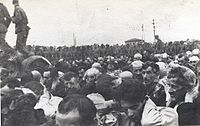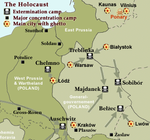
Bialystok Ghetto
Encyclopedia


Nazi Germany
Nazi Germany , also known as the Third Reich , but officially called German Reich from 1933 to 1943 and Greater German Reich from 26 June 1943 onward, is the name commonly used to refer to the state of Germany from 1933 to 1945, when it was a totalitarian dictatorship ruled by...
between July 26 and early August of 1941 in the new capital of Bezirk Bialystok
Bezirk Bialystok
The Bezirk Bialystok , also Belostok was an administrative unit that existed during the World War II occupation of Poland by Nazi Germany...
district of German-occupied Poland. About 50,000 Jews from the vicinity of Białystok and the surrounding region were herded into a small area of the city. The ghetto
Ghetto
A ghetto is a section of a city predominantly occupied by a group who live there, especially because of social, economic, or legal issues.The term was originally used in Venice to describe the area where Jews were compelled to live. The term now refers to an overcrowded urban area often associated...
was split in two by the Biala River running through it (see map). Most inmates were put to work in the forced-labor enterprises, primarily in large textile factories established within its boundaries. The ghetto was liquidated in November 1943 as soon as the courageous Białystok Ghetto Uprising was extinguished. All its inhabitants were either killed locally or transported in cattle trucks to the Majdanek and Treblinka extermination camp
Treblinka extermination camp
Treblinka was a Nazi extermination camp in occupied Poland during World War II near the village of Treblinka in the modern-day Masovian Voivodeship of Poland. The camp, which was constructed as part of Operation Reinhard, operated between and ,. During this time, approximately 850,000 men, women...
.
Ghetto history
The city of Białystok was overrun by the WehrmachtWehrmacht
The Wehrmacht – from , to defend and , the might/power) were the unified armed forces of Nazi Germany from 1935 to 1945. It consisted of the Heer , the Kriegsmarine and the Luftwaffe .-Origin and use of the term:...
on September 15, 1939, and a week later ceded to the invading Red Army
Soviet invasion of Poland
Soviet invasion of Poland can refer to:* the second phase of the Polish-Soviet War of 1920 when Soviet armies marched on Warsaw, Poland* Soviet invasion of Poland of 1939 when Soviet Union allied with Nazi Germany attacked Second Polish Republic...
in accordance with Molotov–Ribbentrop Pact. On September 27, 1939, it was annexed by the Soviet Union following mock elections
Elections to the People's Assemblies of Western Ukraine and Western Belarus
Elections to the People's Assemblies of Western Ukraine and Western Belarus, which took place on October 22, 1939, were an attempt to legitimate territorial gains of the Soviet Union, at the expense of the Second Polish Republic...
. According to the terms of the German-Soviet Pact signed earlier in Moscow, Białystok remained in Soviet hands until June 1941, assigned to the Belarusian Soviet Socialist Republic. Thousands of Jews flocked to the city from German-occupied Poland. Mass deportations to Siberia by the NKVD
NKVD
The People's Commissariat for Internal Affairs was the public and secret police organization of the Soviet Union that directly executed the rule of power of the Soviets, including political repression, during the era of Joseph Stalin....
followed.
The German army
Wehrmacht
The Wehrmacht – from , to defend and , the might/power) were the unified armed forces of Nazi Germany from 1935 to 1945. It consisted of the Heer , the Kriegsmarine and the Luftwaffe .-Origin and use of the term:...
entered the Soviet occupation zone
Soviet occupation of Poland
Soviet occupation of Poland can refer to*Period from 1939 to 1941 - see Occupation of East Poland by Soviet Union*Period from 1945-1989 - see Northern Group of Forces...
on June 22, 1941 under the codename Operation Barbarossa
Operation Barbarossa
Operation Barbarossa was the code name for Germany's invasion of the Soviet Union during World War II that began on 22 June 1941. Over 4.5 million troops of the Axis powers invaded the USSR along a front., the largest invasion in the history of warfare...
and took over the city within days. On June 28 the Great Synagogue was burned down with 800 to 1,000 Jews locked in it. The "Red Friday" took the lives of up to 5,000 Jewish victims – a harbinger of things to come. Himmler visited Białystok on June 30, 1941 during the formation of the new Bezirk district and pronounced that there is a high risk of Soviet guerrilla activity in the area, with Jews being of course immediately suspected of helping them out. The mission to destroy the alleged NKVD
NKVD
The People's Commissariat for Internal Affairs was the public and secret police organization of the Soviet Union that directly executed the rule of power of the Soviets, including political repression, during the era of Joseph Stalin....
collaborators was assigned to Einsatzgruppe B under the command of SS-Gruppenführer Arthur Nebe
Arthur Nebe
SS-Gruppenführer Arthur Nebe was a member of the NSDAP party with card number 574,307. In July 1931, he joined the SS and his membership number was 280,152. His early career included the Berlin position of Police Commissioner in the 1920s...
aided by Kommando SS Zichenau-Schroettersburg under Hermann Schaper and Kommando Bialystok led by Birkner
Wolfgang Birkner
SS-Hauptsturmführer Wolfgang Birkner was a Nazi war criminal and Holocaust perpetrator. He was a member of the NSDAP party with card number 3,601,309, and...
summoned from the General Government
General Government
The General Government was an area of Second Republic of Poland under Nazi German rule during World War II; designated as a separate region of the Third Reich between 1939–1945...
on orders from the Reich Main Security Office. In the early days of the German occupation, these mobile killing units rounded up and killed thousands of Jews in and around Białystok, before and after the creation of the actual Ghetto with up to 60,000 Jewish prisoners in it. Textile and armament factories were established with the help of Judenrat
Judenrat
Judenräte were administrative bodies during the Second World War that the Germans required Jews to form in the German occupied territory of Poland, and later in the occupied territories of the Soviet Union It is the overall term for the enforcement bodies established by the Nazi occupiers to...
, along with soup kitchen, first aid site and other amenities. Food rations were strictly enforced.
On February 5–12, 1943, the first group of approximately 10,000 Białystok Jews were sent to their deaths in cattle trucks at the Treblinka extermination camp
Treblinka extermination camp
Treblinka was a Nazi extermination camp in occupied Poland during World War II near the village of Treblinka in the modern-day Masovian Voivodeship of Poland. The camp, which was constructed as part of Operation Reinhard, operated between and ,. During this time, approximately 850,000 men, women...
. Up to 2,000 victims were shot on the spot for insubordination among those too weak or sick to run for the wagons. Approximately 7,600 inmates were put in a new central transit camp within the city for their further selection. Those fit to work were sent to the Majdanek
Majdanek
Majdanek was a German Nazi concentration camp on the outskirts of Lublin, Poland, established during the German Nazi occupation of Poland. The camp operated from October 1, 1941 until July 22, 1944, when it was captured nearly intact by the advancing Soviet Red Army...
camp. In Majdanek, after another screening for ability to work, they were transported to the Poniatowa, Blizyn, and Auschwitz labor camps. Those deemed too weak to work were murdered at Majdanek. More than 1,000 Jewish children were sent first to the Theresienstadt
Theresienstadt concentration camp
Theresienstadt concentration camp was a Nazi German ghetto during World War II. It was established by the Gestapo in the fortress and garrison city of Terezín , located in what is now the Czech Republic.-History:The fortress of Terezín was constructed between the years 1780 and 1790 by the orders...
ghetto in Bohemia
Bohemia
Bohemia is a historical region in central Europe, occupying the western two-thirds of the traditional Czech Lands. It is located in the contemporary Czech Republic with its capital in Prague...
, and then to Auschwitz-Birkenau
Auschwitz concentration camp
Concentration camp Auschwitz was a network of Nazi concentration and extermination camps built and operated by the Third Reich in Polish areas annexed by Nazi Germany during World War II...
, where they were killed. Only a few months later, as part of Aktion Reinhard, on August 16, 1943 the ghetto was raided by regiments of the German SS with Ukrainian, Byelorussian and Latvian auxiliaries aiming at the ghetto's final destruction.
Faced with the final deportations, when all hope for survival was abandoned, the ghetto underground staged an uprising against the Germans. In the night of August 16, 1943, several hundred Polish Jews began an armed insurrection against the troops carrying out the liquidation of the Ghetto.
"The blockade of the ghetto lasted one full month and on the 15th of September 1943, after the last of the flames of resistance had been extinguished, the SS units retreated," and the final stage of mass deportations commenced, wrote Szymon Datner
Szymon Datner
Szymon Datner was a Polish historian of Jewish descent, best known for his studies of Nazi war crimes committed against the Jewish population of the Białystok area after the German attack on the Soviet Union in June 1941.Datner settled into Białystok in 1928...
, a Holocaust survivor. Only about one hundred Jews managed to escape and join various partisan groups in the Białystok area including Soviet. The Red Army
Red Army
The Workers' and Peasants' Red Army started out as the Soviet Union's revolutionary communist combat groups during the Russian Civil War of 1918-1922. It grew into the national army of the Soviet Union. By the 1930s the Red Army was among the largest armies in history.The "Red Army" name refers to...
liberated Białystok in August 1944.

